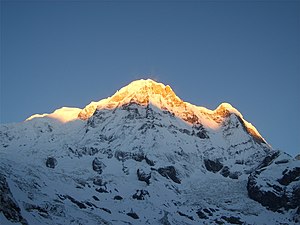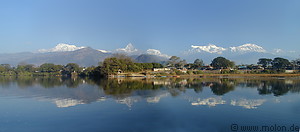
om/t1/95/360595/4/58494689.jomsomtrek.jpg" alt="Location of

Muktinath is situated in the Annapoorna hills at an altitude of 3600 Metres. It is one of the dangerous hills, for 40% of the climbers do not survive.



River Gantaki flows and later joins Ganga. Travel to Muktinath can be seen at http://www.ramanuja.org/sv/bhakti/archives/sep97/0045.html. This river is black in color, just as the saligrama stones it has. It is also called Kali Gantaki river. We will see more about history of Salagrama in the coming days. From here, we will now see sloka 4 of Chapter 18:
niścayaṃ śṛṇu me tatra tyāge bharatasattama
tyāgo hi puruṣavyāghra trividhaḥ saṃprakīrtitaḥ 18.4
The Lord addresses Arjuna as Bharata sattama [most noble among Bharata dynasty] and Purusha vyagra [Tiger among men]. Perhaps, this is to arouse Arjuna to grasp the essence of Sri Krishna's teachings and raise in level! Srunu me = listen to Me [Sri Krishna], niscayam tatra tyage = be sure of that sacrifice [is what He told in Chapter 3 and not to discard any karma, as mentioned in the Second half of sloka 3 of Chapter 18]. Sri Krishna had reiterated doing our karmas, as the path to Moksham. Here, we have to be careful to understand this sloka. It is not that the Lord is giving His decisive opinion here. If that was so, then in slokas 2 and 3, there would have been Four opinions and the Lord is giving His opinion here. This is not the case. The Lord had given the opinions of Three groups and in sloka 3 itself, in the Second line, He has confirmed that His opinion is that all karmas had to be done and this was evident in Chapter 3 also. Tyago hi = even this tyaga or sacrifice, trividah = is of Three types, samprakirtita = as understood. They are Kartrutva buddhi tyagam, mamata tyagam and phala tyagam. Mamata means 'my' or when doing a karma we have the feeling that the karma is done by us, it would beget the result we desired, etc. This feeling that karma is ours, has to be sacrificed or discarded. Phala tyagam means excepting desire to reach Moksham and serving the Lord, no other rewards should be aspired for, while doing a karma. Doing a karma for other benefits, will involve us in this samsaram and would not liberate us. He is going to explain further that all karmas had to be done; but with a different frame of mind. The Lord would never advocate discarding karmas. Coming to such remote places, we continue to do our daily rituals and pitru tarpanam, etc. Can we ever think of renouncing any of them? But while doing those karmas, these three types of sacrifices should always be borne in mind. We will see more as we progress in our journey along Gantaki river.
3 comments:
Thank you, Sir, for directing me to this site. It is very nice, but just now I am on the job of translation. So, I will read at my leisure.
Namaskaram Sri Saranathan,
When adiyen read through your posts,adiyen could imagine how Krishnan swami would have spoken.
Great work for humanity by him and by you.
Dasan
Dear Sir, thanks for the encouragement. What Sri UVe. Velukkudi Swami is doing is certainly a service to humanity. Like the legendary squirrel I am also a microscopic part of that service.
Thank you once again, Sir.
Post a Comment